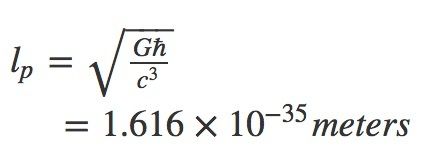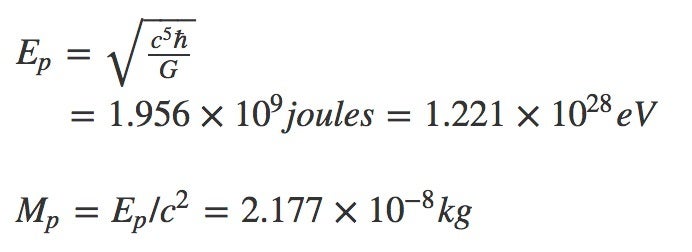
What is the significance of Planck time, Planck length, and Planck mass? originally appeared on Quora- the place to gain and share knowledge, empowering people to learn from others and better understand the world.
Answer by Frank Heile, Ph.D. Physics, Stanford University, on Quora:
There are lots of constants in physics. For example, there is the mass of the electron, the charge of the electron, the ratio of the mass of the electron to the mass of the proton, the wavelength of light emitted by a certain atomic transition, etc. But all of these are constants are related, in one way of another, to particular kinds of objects in our universe - they do not apply to everything in the universe so they are not truly fundamental.
There are, in fact, only a few fundamental constants that have units that could be combined to make a length, a time or an energy unit. Again, by fundamental, I mean constants that apply to the entire universe in one way or another. In fact the only known truly fundamental constants are:
- c - the speed of light. This is not just the speed of light, it is really the conversion factor between the time dimension and the three space dimensions in our 4 dimensional space-time. It has units of distance / time. Can't get much more fundamental than that: speed of light! (For more about c as a space-time conversion factor see this answer.)
- ħ - the fundamental constant that sets the scale for quantum phenomena. It has units of action or energy-time of mass * distance^2 / time. Again a constant that applies to everything in the universe: planck constant
- G - the Newtonian gravitational constant that is also used in General Relativity. All matter and all energy in the universe attracts all other energy and matter in the universe via the curvature of 4 dimensional space time. Again this applies to the entire contents of the universe. It has units of length^3 / (mass * time^2): gravitational constant
There is one other constant that seems to be fundamental: the Boltzmann constant (boltzmann constant). This constant has units of energy / degree Kelvin and therefore the Boltzmann constant is really just the definition of 1 degree Kelvin. So the Boltzmann constant is not really a fundamental constant that tells us something about the universe.
So, that's it, there are no other fundamental constants that apply to the entire universe and all of its contents.
Now from these 3 fundamental constants, we can construct scales of length, time and energy as follows:
Planck Length (see planck length)

Planck Time (see planck time)

Planck Energy (see planck energy)

So, "fundamentally", the Planck Scale is the only scale that applies to everything in the universe. Therefore, these units are the most natural units to use for measurements of distance, time, energy and mass. In fact, theoretical physicists often work in a system of units where c=1, ħ=1 and G=1 - from the formulas above you can see that the units they are using in this case are exactly the Planck Scale units since all the Planck units would have a numerical value of "1" if c=1, ħ=1 and G=1!
In terms of the significance of the Planck Scale:
- It is thought to be the scale of the strings of String Theory. So strings are about as long as the Planck length and vibrate on Planck time scales.
- If the Planck energy is confined to the volume of a cube of size 1 Planck length it will form a black hole. In fact, this is thought to be the smallest possible mass for a black hole and at these "Planck" distances, times and energies it is thought that quantum gravitational effects will be very significant.
- The Planck length is the smallest distance scale we can probe with accelerators. High energy accelerators are used to probe small objects, such as the quarks inside protons, so the goal is always to build higher energy accelerators. However, if we could build an accelerator that achieved the Planck energy for a particle like the electron, when the electron interacted with the target, a black hole would form and it would not help to go to higher energies than that since the black hole would just get bigger. That is why the Planck length is the smallest length scale that we could theoretically probe.
- The Planck time is the time it takes for light to traverse a Planck length.
- At about the Planck time after the big bang, it is thought that gravitation would separate from the three other forces of nature (strong, weak and electromagnetic forces)
There are many speculations about other things that could happen at the Planck scale. For example,
- Space-time could become a chaotic quantum foam due to the gravitational fluctuations from quantum fluctuations at that scale.
- Space-time could become quantized (which would cause violations of Lorentz invariance at the Planck scale.
But I repeat, these are speculations - we really do not know what happens at the Planck Scale.
One interesting note, the Planck length and Planck time are far smaller by many orders of magnitude than lengths or times we can measure. Macroscopic objects have energies far higher than the Planck energy. However if you divide the energy of a macroscopic body by the number of particles in the body, the energy per particle is many orders of magnitude less than the Planck energy. For example, the highest energy cosmic ray ever detected is estimated to have an energy of 3 * 10^20 eV which is 8 orders of magnitude below the Planck energy (see Oh-My-God particle). This highest energy cosmic ray did have the kinetic energy equal to that of a 5-ounce (142 g) baseball traveling at about 100 kilometers per hour (60 mph). To get to a Planck energy, consider the chemical energy stored in an automobile gas tank (57.2 L of gasoline at 34.2 MJ/L) - this is approximately a Planck energy. So a Planck energy could drive your car a few hundred miles or km!
The Planck mass is approximately 1% of the mass of a typical mosquito (see planck mass - Wolfram|Alpha), so the energy of that tank of gasoline is equivalent to 1% of a mosquito mass being converted to energy! The basic reason why the Planck mass is so large is because the gravitational force in this universe is very weak. The Plank Mass confined to a Planck Volume will be a black hole and because gravity is so weak it takes a large amount of mass for the gravity to be strong enough to form a black hole in that volume.
This question originally appeared on Quora - the place to gain and share knowledge, empowering people to learn from others and better understand the world. You can follow Quora on Twitter, Facebook, and Google+. More questions:
